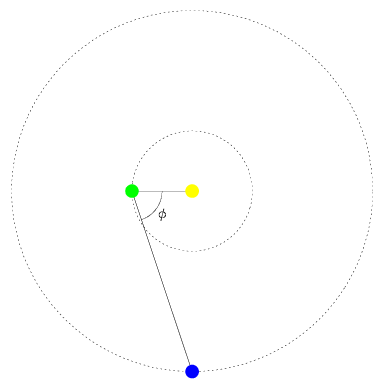Albedo
The albedo
of a surface is the ratio of reflected and scattered flux to incident
flux. We define several variants of albedo below. Note that A +
+ 
 = 1, where
= 1, where  is the emissivity,
in the case where there is no scattering. The geometric albedo (head-on
reflectance) is the amount of radiation relative to a diffuse, perfect
reflector at all wavelengths. We define the phase angle
is the emissivity,
in the case where there is no scattering. The geometric albedo (head-on
reflectance) is the amount of radiation relative to a diffuse, perfect
reflector at all wavelengths. We define the phase angle  as the angle of reflectance through
which an object redirects the flux (e.g. from the Sun towards the Earth).
as the angle of reflectance through
which an object redirects the flux (e.g. from the Sun towards the Earth).
 |
 |
| [NMSU, N. Vogt] |
For a planet in equilibrium, the equilibrium temperature is a function of
the absorbed solar flux. It must re-emit the incident flux, in a fashion
which we model as a blackbody. Exceptions: Jupiter, Saturn and Neptune
generate internal heat, while Venus has a hotter surface temperature due to
the greenhouse effect (the upper atmosphere temperature agrees with that
predicted by the blackbody model).
The sunlit hemisphere of a spherical body receives solar flux depending
upon its radius R and its distance from the Sun r.
If it rotates quickly, it will re-radiate from the entire spherical
surface.
By setting the incident and the re-radiated flux equal to each other, we
can determine the equilibrium temperature, T.
In the case of a slowly rotating body, what can we say about the
equilibrium temperature at the subsolar point?
 +
+ 
 = 1, where
= 1, where  is the emissivity,
in the case where there is no scattering. The geometric albedo (head-on
reflectance) is the amount of radiation relative to a diffuse, perfect
reflector at all wavelengths. We define the phase angle
is the emissivity,
in the case where there is no scattering. The geometric albedo (head-on
reflectance) is the amount of radiation relative to a diffuse, perfect
reflector at all wavelengths. We define the phase angle  as the angle of reflectance through
which an object redirects the flux (e.g. from the Sun towards the Earth).
as the angle of reflectance through
which an object redirects the flux (e.g. from the Sun towards the Earth).




